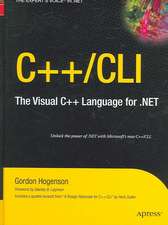Personal Finance with Python: Using pandas, Requests, and Recurrent
Autor Max Humberen Limba Engleză Paperback – 21 iul 2018
Deal with data, build up financial formulas in code from scratch, and evaluate and think about money in your day-to-day life. This book is about Python and personal finance and how you can effectively mix the two together.
In Personal Finance with Python you will learn Python and finance at the same time by creating a profit calculator, a currency converter, an amortization schedule, a budget, a portfolio rebalancer, and a purchase forecaster. Many of the examples use pandas, the main data manipulation tool in Python. Each chapter is hands-on, self-contained, and motivated by fun and interesting examples.
Although this book assumes a minimal familiarity with programming and the Python language, if you don't have any, don't worry. Everything is built up piece-by-piece and the first chapters are conducted at a relaxed pace. You'll need Python 3.6 (or above) and all of the setup details are included.
What You'll Learn
- Work with data in pandas
- Calculate Net Present Value and Internal Rate Return
- Query a third-party API with Requests
- Manage secrets
- Build efficient loops
- Parse English sentences with Recurrent
- Work with the YAML file format
- Fetch stock quotes and use Prophet to forecast the future
Who This Book Is For
Anyone interested in Python, personal finance, and/or both! This book is geared towards those who want to manage their money more effectively and to those who just want to learn or improve their Python.
Preț: 248.94 lei
Preț vechi: 311.18 lei
-20% Nou
Puncte Express: 373
Preț estimativ în valută:
47.63€ • 49.73$ • 39.42£
47.63€ • 49.73$ • 39.42£
Carte disponibilă
Livrare economică 15-29 martie
Preluare comenzi: 021 569.72.76
Specificații
ISBN-13: 9781484238011
ISBN-10: 148423801X
Pagini: 110
Ilustrații: XVI, 117 p. 36 illus.
Dimensiuni: 155 x 235 x 25 mm
Greutate: 0.2 kg
Ediția:1st ed.
Editura: Apress
Colecția Apress
Locul publicării:Berkeley, CA, United States
ISBN-10: 148423801X
Pagini: 110
Ilustrații: XVI, 117 p. 36 illus.
Dimensiuni: 155 x 235 x 25 mm
Greutate: 0.2 kg
Ediția:1st ed.
Editura: Apress
Colecția Apress
Locul publicării:Berkeley, CA, United States
Cuprins
1. Setup.- 2. Profit.- 3. Convert.- 4. Amortize.- 5. Budget.- 6. Invest.- 7. Spend.- Next.
Recenzii
“The book is not only a love letter to pandas--each financial aspect treated in the book becomes a love letter for Requests, Matplotlib, Recurrent, NumPy, YAML, and the like.” (Pierre Radulescu-Banu, Computing Reviews, September 27, 2019)
Notă biografică
Max Humber is a Data Engineer interested in improving finance with technology. He works for Wealthsimple, and previously served as the first data scientist for the online lending platform Borrowell. He has spoken at Pycon, ODSC, PyData, useR, and BigDataX in Colombia, London, Berlin, Brussels, and Toronto.
Textul de pe ultima copertă
Deal with data, build up financial formulas in code from scratch, and evaluate and think about money in your day-to-day life. This book is about Python and personal finance and how you can effectively mix the two together.
In Personal Finance with Python you will learn Python and finance at the same time by creating a profit calculator, a currency converter, an amortization schedule, a budget, a portfolio rebalancer, and a purchase forecaster. Many of the examples use pandas, the main data manipulation tool in Python. Each chapter is hands-on, self-contained, and motivated by fun and interesting examples.
Although this book assumes a minimal familiarity with programming and the Python language, if you don't have any, don't worry. Everything is built up piece-by-piece and the first chapters are conducted at a relaxed pace. You'll need Python 3.6 (or above) and all of the setup details are included.
You will:
•Work with data in pandas
•Calculate Net Present Value and Internal Rate Return
•Query a third-party API with Requests
•Manage secrets
•Build efficient loops
•Parse English sentences with Recurrent
•Work with the YAML file format
•Fetch stock quotes and use Prophet to forecast the future
Caracteristici
Contains a compact primer on personal finance planning and management using Python Organized around financial concepts including profit, budgeting, investing, amortization, and more Inspired by the author's conference presentations on the same topic



























